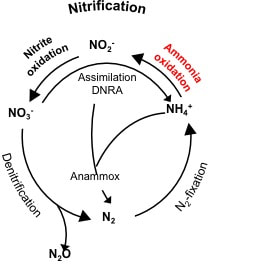- Organic such as proteins and urea
- Ammonium/ammonia - the most toxic to animal life
- Nitrite
- Nitrate
- NO/N2 - gas
Microbes use nitrogen for cell maintenance and growth with nitrogen being used primarily for enzymes and proteins. Nitrogen accounts for 9 - 15% of the dry weight of cells. Bacteria can use many forms of nitrogen with the most efficiently used being ammonium with some organisms being able to use nitrogen gas (fixation) when other forms of nitrogen are deficient. Under anoxic conditions, many heterotrophic organisms can use nitrate or nitrite as an alternative electron acceptor (oxygen substitute). This produces NO/N2 gas - often seen as fine bubbles on the surface of clarifiers or lagoons. Another part of the nitrogen cycles includes heterotrophic oxidation of ammonia. While much less understood than chemoautotrophic nitrification, some heterotrophic microbes engage in ammonia oxidation in wastewater treatment. Research on the organisms and triggers for ammonia oxidation are ongoing - this also starts to dovetail into the Anammox cultures.
Chemoautotrophic Cycles
When we think of ammonia removal in wastewater, we usually discuss chemoautotrophic nitrification. These organisms including Nitrosomonas & Nitrobacter - obtain energy via the conversion of ammonia into nitrite and finally nitrate. This is an obligate aerobic process and consumes substantial alkalinity. Both AOB & NOB microbes are relatively slow growing and susceptible to toxic shocks.
Anammox Cycles
These are slow growing, interesting microbes that use nitrite and ammonia as inputs to generate energy. The nitrite + ammonia --> nitrogen gas (N2) + water. To achieve a significant population of Anammox organisms, requires fixed film reactors or very long sludge ages. To supply Anammox cultures with nitrite requires AOB converting ammonia into nitrite. The benefits of Anammox being avoiding the need to convert nitrite to nitrate (NOB) and then removing the nitrate via anoxic microbial activity.


 RSS Feed
RSS Feed